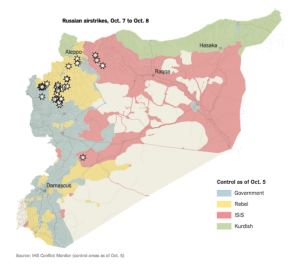Missile Misfire: Stray Russian Airstrike Hits Iran, Not Syria
According to a CNN report, on October 8 Russian missiles headed to Syria as part of Moscow’s recent airstrike campaign instead landed in Iran. Citing two unnamed U.S. officials, CNN claimed that four missiles “never made it over Iran to Syria.”
The Pentagon has remained silent on the topic of the allegedly misfired missiles even as East-West tensions continue to escalate.
Russian officials deny CNN’s allegations. Russian Defense Ministry spokesman Igor Konashenkov assured Russia Today that the missiles hit their targets.
“Unlike CNN, we don’t distribute information citing anonymous sources,” Konashenkov said.
Iran, Russia’s only ally supporting Syrian President Bashar al-Assad’s regime in Damascus, also refuted the accusations.
Calling the reports of Russian missiles landing in Iran “blatant lies,” Iranian General Musa Kamali stated, “The U.S. made similar allegations in the past as part of their psychological warfare against whoever opposes their policies in the region.”
The Russian Parliament approved President Vladimir Putin’s request to launch airstrikes into Syria on September 30. The Russian government framed their first direct involvement in the Middle East since the invasion of Afghanistan as a campaign to fight all terrorists, not just the self-styled Islamic State group (IS).
In his interview with Charlie Rose on 60 minutes filmed months before the first Russian missile was fired, Putin accused the U.S. of aiding the Syrian rebels fighting against Assad’s regime and thereby creating the regional instability that led to the rise of IS.
“We provide assistance to legitimate Syrian authorities,” Putin said. “It is only up to the Syrian people living in Syria to determine who, how, and based on what principles should rule their country, and any external advice of such kind would be absolutely inappropriate, harmful, and against international law.”
Throughout the Syrian conflict, the U.S. and Russia have once again found themselves on opposing sides. Russia has been unyielding in its support of Assad’s regime even as the U.S. continues to provide supplies, equipment, and military training to the Free Syrian Army.
Now, as the threat posed by the Islamic State group escalates, the two nations find themselves struggling to work together in a loosely formed coalition. Turkey and Saudi Arabia, both staunch critics of Assad’s regime, allied with the U.S. to help fight IS, while Iran and Russia support Damascus.
Russian media frequently cites U.S. inability to effectively put a stop to terrorism in Syria and Iraq as the primary reason for Russian involvement. Keeping in mind Putin’s recent moves on the international stage – particularly his annexation of Crimea and thinly concealed support of Russian separatists in Ukraine – political benefits of his Syrian campaign are clear. The airstrikes are just one of multiple steps Russia has taken to reassert its dominance in global affairs.
Whatever its primary motives, Russia is not using their rockets to single out IS. The Syrian Civil Defense Twitter account claims the Russian airstrike in Homs killed 33 civilians on September 30 alone. Many Russian missiles are landing in rebel-controlled areas, where IS forces are barely present.
Russia also has direct ties to the region with the Syrian port of Tartous as their last naval base in the Middle East. Given Putin’s resolute support of Assad’s regime, Russian rockets could wreak havoc upon the Syrian opposition even as they supposedly target terrorists. Despite Putin’s supposed adherence to international law and his encouragement of the Syrian people to decide their own fate, there may not be enough Syrians left to oppose to Assad when the fight with IS is over.

